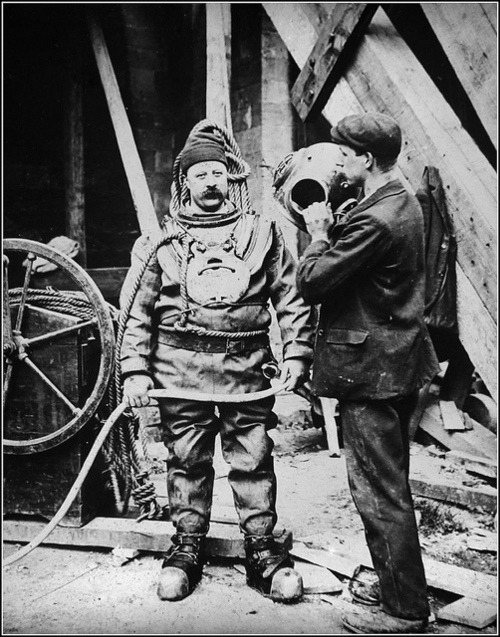William Walker, the man who dove under a cathedral — The restoration of Winchester Cathedral,
William Walker, the man who dove under a cathedral — The restoration of Winchester Cathedral, 1905 - 1912.Located in Hampshire near the southern coast of England and built by the Normans in 1079, Winchester Cathedral is one of England’s oldest and most important Cathedral’s. Being over 900 years old it was the place where many coronations and weddings of medieval English monarchs occurred. It is also the resting place of various ancient Saxon kings, medieval religious leaders, and the 18th century novelist Jane Austin. However by the turn of the century it was evident that the ancient cathedral was in trouble. Cracks were forming all throughout the building, walls began to slant and bow, and on occasion blocks from fall from the roof. After inspection by architects the problem was clear, the cathedral was sinking into the ground and it was only a matter of time before the building crumbled and collapsed.After a massive fundraising campaign led by the Dean of Winchester William Ferneaux, a work crew was hired led by the architect T. G. Jackson and the engineer Francis Fox. Before the cathedral itself could be repaired, the faulty foundation of the building had to be repaired. The workers built large support structures on the walls so that the building would not collapse as the foundation was removed. When the work crew dug down to the foundation, they were amazed by what they found.When the Normans built Winchester Cathedral, the area was basically a swamp. To provide a foundation for the building the Normans placed a multilayer platform of beech trees over the peat of the bog. Essentially the cathedral was built on a large raft that “floated” on a layer of sponge like peat (an accumulation of decayed vegetation common to bogs). Many of these logs were rotting away, causing the building above to sink and sag. Upon further excavation the team found a layer of natural limestone gravel about 2 dozen feet below ground level, the perfect base for a new foundation. The plan was to dig out, piece by piece, the old foundation and replace it with a new foundation of cement, concrete block, and brick.However, when the work crews began digging out the layer of peat, ground water began to seep up, flooding the excavated areas. It turns out that the layer of peat had served as a cap that prevented ground water from rising. A steam powered pump was brought in to pump out the water, but pumping the water caused an erosion of silt, further weakening the existing foundation and increasing the danger that the cathedral would collapse as they were working. Jackson ordered the pumping to be halted. Initially it was unclear how the work would continue, but Fox had a solution.Fox called upon the services of an ex navy salvage diver named William Walker. Walker was the most experienced divers in Britain and had thousand of hours of underwater experience. However, this task was unlike any other he had accomplished. Walker dove in the trenches under the cathedral walls, removing the old foundation timbers, digging out the layer of peat, and laying wet drying cement, concrete block, and brick. Working conditions were terrible and dangerous. As he dived his every movement stirred sediment, making the water-scape a cloudy, muddy, mess. Fox himself made a few dives, and described the conditions,“Only one person can be down in the water at a time, it is very cramped. There is a distinct feeling of loneliness, as it is absolutely dark, the water being thick with peat and also septic from the graves. The natural light is practically useless, one is conscious of staring with ones eyes wide open even if nothing can be seen. But somehow, the sensation of feeling the excavation with the hands made it possible to form a mental picture. And of course, the imagination plays tricks. One is conscious, of course, of the graves all around, of the presence of so many bodies, of ancient cadavers.”Many parts of the building had been used as a graveyard for medieval plague victims. Walker worked among the ancient skeletons of these victims, and it was feared that the water could have been contaminated with black death. Walker claimed that he chewed tobacco to stave off the disease. There was also the risk that the cathedral would collapse, burying him alive.Walker worked for six years, from 1905 to 1911. He worked 5 days a week for six hours a day, taking a short break every three hours. During this time he packed the foundations with more than 25,000 bags of concrete, 115,000 concrete blocks, and 900,000 bricks. All of this was done while working in depths of twenty feet, working half blind and wearing a 100 pound diving suit. Work was completed in 1912. When the foundation was completed the water was pumped out, and the new foundation created a seal which prevented any more water from rising. The building was repaired and Gothic style buttresses were added to further strengthen the cathedral. Walker was honored by being presented a silver rose bowl by King George V, who had actually been instructed by Walker while he studied at the Naval Academy. Walker was also honored by being appointed to the Royal Victorian Order. Unfortunately he passed away a victim of the Great Flu Epidemic of 1918. Today, in the midst of various memorials to ancient English kings, queens, and nobles, a memorial to his service can be found in Winchester Cathedral.Sources,winchester-cathedral.orgBBC Documentary; Cathedral - Flood at Winchester (https://www.youtube.com/watch?v=izLkrr70iEY) -- source link
#history#winchester cathedral#engineering#middle ages#medieval#diving#navy#diver#william walker#architecture


